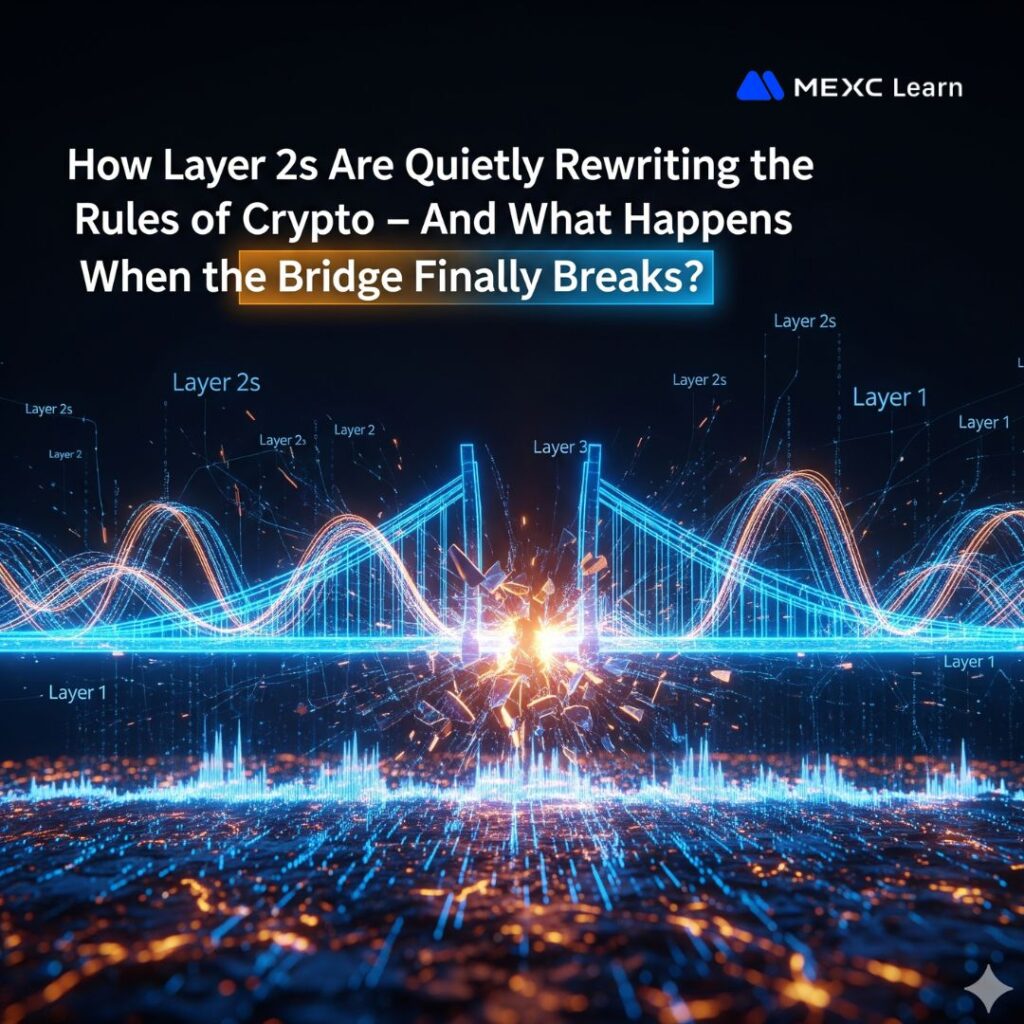
It’s a crisp September evening in 2025, and I’m staring at my screen, Ethereum‘s price chart flickering like a heartbeat at $4,074, an all-time high that’s got the whole crypto Twitterverse buzzing like a hive on caffeine. But here’s the thing: While everyone’s toasting ETH’s moonshot, something weirder, wilder is unfolding beneath the surface. Layer 2s—those scrappy sidekicks to Ethereum’s mainnet—aren’t just scaling the beast anymore. They’re devouring it.
1.Layer 2s: The New Powerhouse of Ethereum
Gas fees? Down to a whisper at 1.314 Gwei, a 65% plunge from last year, thanks to upgrades like Pectra and Fusaka that make transactions feel like they’re on cheat codes. Bridges? They’re shuttling $11.2 billion in assets monthly, turning Ethereum into a multi-lane highway of interconnected worlds. And active users? Base alone hit 3.2 million in March, with L2s now boasting 487,000 daily addresses, outpacing the mainnet like a kid outrunning their shadow.
This isn’t just tech evolution; it’s a macro narrative that’s sucking in trillions of DeFi, RWAs, and even TradFi suits eyeing the yield. But as I sip my coffee and scroll through Vitalik’s latest thread on quantum-safe scaling, I can’t shake this nagging question: What if the bridges—those fragile links holding it all together—snap under the weight? Stick with me; this story starts with a bang but ends in a twist that might just redefine everything you thought you knew about where crypto’s headed.
2.Ethereum’s Evolution: From the Merge to Dencun
Let’s rewind the tape, because Ethereum’s journey feels like that epic fantasy saga where the hero survives the dragon but wakes up in a stranger land. Back in 2022, the Merge flipped Ethereum to proof-of-stake, slashing energy use by 99% and stabilizing those wild fee swings that once turned a simple NFT mint into a $50 gamble. Fast-forward to 2025, and the Dencun upgrade (EIP-4844, or proto-danksharding for the nerds) threw open the floodgates. Blob space cheap data storage for rollups crushed L1 gas fees from $3.78 averages to sub-$0.03 on L2s, making DeFi swaps and NFT drops accessible to normies who wouldn’t touch crypto with a ten-foot pole.
3.Gas Fees: From Villain to Hero
Ethereum’s mainnet, once a congested toll road at 25-35 TPS (transactions per second), now hums at a sustainable clip, with gas usage down 30% as users flock to L2s for the real action. It’s macro magic: Lower costs mean more micro-transactions, think remittances in Latin America zipping across borders at pennies, or gamers in Asia battling in metaverses without pausing to pray for low fees. The Fear & Greed Index? It’s neutral at 51, but L2 activity’s up 20% year-over-year, signaling a quiet bull that’s more substance than hype.
4.Ethereum’s Fee Renaissance: A New Era for DeFi
Gas fees, that eternal Ethereum villain, are the unsung hero here, or at least, they’re on probation. Mid-2025 averages sit at $1.85 on mainnet, but hop to an L2 like Arbitrum or Optimism, and you’re paying $0.08, a 95% haircut that Vitalik himself called “transformative” in a recent AMA. Why the drop? Fusaka’s block gas limit expansions and EIP-4844‘s data blobs offloaded the heavy lifting, compressing rollup proofs into bite-sized posts back to L1. No more $95 spikes during DeFi rushes; now, even complex swaps hover under a buck.
But it’s not all rainbows – volatility lingers. February’s $50 fee surge on a busy swap day reminded us: Congestion hits, and L1 still chokes at peak hours. On X, devs are geeking out: “Gas at 4 Gwei during ATH? Ethereum’s finally playable,” one posts, while another warns, “L2s are great, but mainnet’s the soul, don’t forget the roots.” This fee renaissance isn’t just saving wallets; it’s macro fuel. BlackRock’s ETHA ETF slurped $2.3 billion in August inflows, 70% of the pie, as institutions bet on ETH’s yield (3-4% staking) without the old gas gouge. DeFi TVL? $162 billion, with L2s like Base and Polygon zkEVM driving 63% QoQ transaction growth in gaming ports alone. It’s like Ethereum woke up leaner, meaner, ready to lap the competition.
5.Bridges: The Double-Edged Sword of Ethereum’s Future
Enter the bridges, those enchanted portals ferrying assets from Ethereum’s fortress to L2 outposts. In Q1 2025, bridging volume exploded to $11.2 billion monthly, a testament to seamless hops via LayerZero and Chainlink’s CCIP, letting your USDC glide from mainnet to Solana or Cosmos without a hitch. Optimism’s Superchain? It’s a coalition of OP-Stack chains (Base, Mode, Zora) where bridges aren’t bottlenecks, but superhighways, enabling cross-L2 composability—your NFT from one game trades in another’s metaverse, no sweat.
Polygon’s zkEVM and Arbitrum’s Orbit stacks push this further, with Stylus letting devs code in Rust or C++ for EVM-compatible magic. But here’s the edge-of-your-seat part: Bridges are double-edged swords.
They’ve lost billions to exploits—remember Ronin’s $625 million hack? Regulators are circling like sharks, eyeing them as money-laundering chokepoints under the GENIUS Act. In 2025, compliance overhead’s rising, with HK’s 1:1 capital ratios and EU’s MiCA demanding traceable flows. Yet, the narrative flips: Secure bridges like Bedrock’s chain factory are deploying OP Chains deterministically, slashing withdrawal times and boosting TVL to $16.28 billion. Macro view? This interoperability isn’t optional; it’s the glue for a $4.17 trillion market cap ecosystem. EigenLayer’s $6 billion in re-staking deposits? That’s bridges securing restaked ETH across L2s, turning idle capital into a yield machine.
6.Active Users: The Real Growth of Ethereum
Now, the human element: Active users. Ethereum’s not a ghost town; it’s a metropolis exploding outward. L2s flipped the script: Arbitrum’s 487,000 daily addresses in Q1, Optimism’s 141 million transactions lifetime, and Base’s 3.2 million actives in March alone. Total L2 activity? Up 20%, with 46.67 million transactions in July, often eclipsing the mainnet as users chase sub-penny fees and 2,000+ TPS on zkSync or StarkNet. Polygon? 65,000 TPS, home to Aave and OpenSea knockoffs, drawing devs who deploy 65% of new smart contracts straight to L2s.
It’s demographic dynamite: Emerging markets like Nigeria and the Philippines lead adoption, where cheap L2 remittances slash 6% bank fees to 2-3%, onboarding millions who skipped Bitcoin’s complexity. Guilds in GameFi? YGG on BNB Chain rents NFTs across L2s, pulling 5.8 million dailies into P2E loops. But the macro ripple? Institutions aren’t far behind. Michigan’s crypto reserve bill (up to 10% state funds) and Australia’s $2.8 trillion pensions eyeing Coinbase’s Base signal TradFi’s quiet invasion.7.
7.Layer 2s: The Heartbeat of Ethereum’s Future
Layer 2s themselves? They’re the rockstars of this saga. Arbitrum dominates with 51% TVL market share, its 4,000 TPS and 95% fee cuts fueling DeFi hubs like GMX. Optimism’s Superchain dreams of interconnected “city-states,” with permissionless withdrawals and modular sequencing for horizontal scaling. zkRollups like Polygon zkEVM and zkSync Era? They’re the privacy ninjas, hitting 3,500 TPS with cryptographic proofs that zap the 7-day fraud windows of optimistic rolls.
Base, Coinbase’s brainchild, blends OP Stack with gasless abstractions via ERC-4337, minting in-game assets without pop-ups, perfect for Immutable’s zkEVM gaming ports. And the wild card? Projects like Plume’s RWA-centric EVM chain,
tokenizing everything from treasuries to real estate with composable DeFi. These aren’t side quests; they’re the main storyline, with L2 TVL at $16 billion and counting, drawing $73 billion in corporate inflows betting on ETH’s infrastructure moat.
8.Quantum Risks: The Unseen Challenge
But here’s where the narrative veers into uncharted waters—the quantum shadow looming over it all. Vitalik’s “Lean Ethereum” blueprint eyes 10,000 TPS on L1 and a million on L2s, but Solana’s Anatoly Yakovenko dropped a bombshell: 50/50 chance quantum tech cracks ECDSA signatures by 2030, potentially doxxing every wallet from Satoshi to your grandma’s stablecoin stash. Ethereum’s response? Quantum-resistant upgrades in Pectra, blending ZK proofs for privacy and re-staking via EigenLayer to harden bridges against exploits. Yet, as L2s fragment into 50+ chains, each with sequencers, validators, and custom gas, the risk multiplies.
A bridge hack cascades; a quantum breach? Catastrophic. Regs like the EU’s digital euro caps and CFTC’s subcommittee add friction, demanding KYC on flows that could stifle the very adoption they’re chasing.
9.Conclusion: Ethereum’s Future – A Hydra or a Phoenix?
So, as September’s Fed cuts juice liquidity and ETH ETFs like BlackRock’s pull in billions, the macro picture sharpens: Ethereum’s not dying; it’s metastasizing through L2s into a hydra of scalability. Gas is cheap, bridges are busy, users are legion, 65% of devs building there, TVL surging, activity eclipsing L1. It’s the backbone for a $4 trillion ecosystem, where RWAs hit $16 billion and gaming DAUs top 5 million.
But that unpredictable twist? In this quantum twilight, Ethereum might not just scale, it could reinvent security itself, turning bridges from vulnerabilities into unbreakable vaults. Or, if one snaps… well, imagine the fallout: A multi-trillion cascade, L2s splintering into sovereign states, and ETH emerging not as king, but as the phoenix oracle of a post-quantum world. The charts say bull; the code whispers revolution. Either way, in 2025’s Ethereum enigma, you’re not just watching history, you’re betting on its rewrite. What’s your stake in the hydra’s next head?
Disclaimer: This article is for informational purposes only and does not constitute financial advice. Cryptocurrency markets are highly volatile and involve significant risks, including the potential loss of principal. Always conduct your own research and consult a financial advisor before investing. Data and figures are sourced as of September 21, 2025, and are subject to change.
Join MEXC and Get up to $10,000 Bonus!



